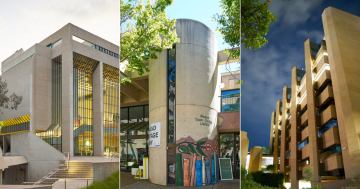
The Shine Dome is part of Canberra’s distinctive modernist architectural history and has now been named in the top ten concrete structures in Australia. File photo.
When it comes to concrete structures, Canberra’s foundations of having the best buildings in Australia has been cemented with two iconic Canberra structures named in the top 10.
The Australian Academy of Science’s Shine Dome and the High Court of Australia were both listed in the top 10 outstanding concrete works in Australia from the past nine decades.
The list was released to mark the 90th anniversary of Cement Concrete and Aggregates Australia (CCAA), which embarked on a quest to find Australia’s most distinctive concrete public architectural landmarks, highlighting the role that concrete has played in Australia’s urban landscape.
Former Government architect and the chair of the judging panel, Peter Poulet said the Australian Academy of Science’s Shine Dome, dubbed the ‘Martian Embassy’ when it was officially unveiled 60 years ago, was a classic structure conceived and built during the space age of the 1950s.
“The Shine Dome is a testament not only to an optimistic view of the future but also as an example of how building materials were being reconceived to represent a dynamic and exciting world,” Mr Poulet says.
Former Prime Minister Robert Menzies said at the laying of the Shine Dome’s foundation stone on 2 May 1958: “I rather like the idea that this stone, simply inscribed then placed in that form, is something that serves as a nexus between this most modern of buildings, as it will be in an older day when buildings of this kind were perhaps never thought of”.
The Shine Dome was created to reflect the inquiring and innovative nature of science. It was the first Canberra building to be added to the National Heritage List for its historical and architectural significance. In 2000, it was one of seven projects which the Royal Australian Institute of Architects nominated to the World Register of Significant Twentieth Century Architecture.
The dome’s construction also proved to be a matter of ingenious engineering to calculate the stresses created by a 710-tonne concrete dome perched on 16 supports. When the concrete dome was built and the wooden formwork and supports removed, the top of the dome dropped less than a centimetre as it took its own weight and was dubbed as a triumph for those who worked on it.
The construction of the High Court began in 1975 and was completed in 1980 at a total cost of $46.5 million. It was officially opened by Her Majesty Queen Elizabeth II on 26 May 1980.
Some 18,400 cubic metres of concrete were used in its construction. Most of the external and internal walls have been subjected to a process known as ‘bush hammering’, carried out with a percussion instrument, which has flaked the surface and exposed the aggregate within the concrete.
Mr Poulet said the High Court’s beautifully crafted monolithic structure gave it the dignity and status of the highest court in the land.
“Built of reinforced concrete, it exemplifies the robust and enduring nature of the institution it contains and represents,” Mr Poulet said.
He said choosing a top 10 from the hundreds of concrete public architectural works in Australia was an extremely challenging but truly rewarding task.
The panel began with 45 nominations which were short-listed to 23 finalists, before reaching a top 10.

The High Court of Australia. Photo: Scott Leggo.
The selection was based on three criteria: architectural merit (the form, function and structure of the building); the innovative, structural and aesthetic use of concrete as a material; and as an example of the time, which determined whether the project redefined and expanded concrete’s potential.
“The buildings and structures remind us of the resilient, enduring beauty of concrete, and it is this durability that makes it a key enabling material to put society on a sustainable transition path,” Mr Poulet said.
The other structures in the top 10 list are:
- The Sydney Opera House
- Australia Square, Sydney – the country’s first ’round’ skyscraper
- The Gladesville Bridge, Sydney
- James Cook University Library, Townsville
- The Melbourne University carpark
- Victorian State Offices
- Punchbowl Mosque, Sydney
- The Queensland Art Gallery, Brisbane.


















